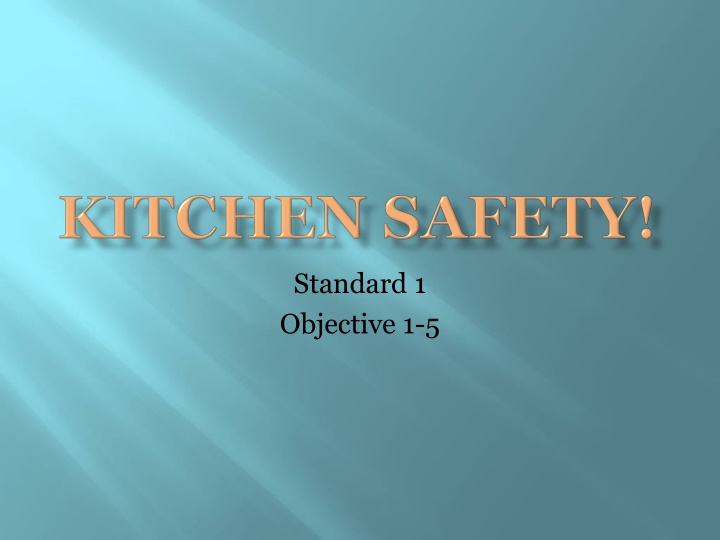Essential Safety Guidelines for Home and Kitchen
Essential safety guidelines for preventing accidents and handling first aid situations at home and in the kitchen. Tips include precautions for using knives, handling spills, preventing burns, lifting heavy items, and dealing with chemical substances. Clear instructions on first aid procedures and how to respond in emergency situations are provided to ensure personal safety and well-being.
Download Presentation

Please find below an Image/Link to download the presentation.
The content on the website is provided AS IS for your information and personal use only. It may not be sold, licensed, or shared on other websites without obtaining consent from the author.If you encounter any issues during the download, it is possible that the publisher has removed the file from their server.
You are allowed to download the files provided on this website for personal or commercial use, subject to the condition that they are used lawfully. All files are the property of their respective owners.
The content on the website is provided AS IS for your information and personal use only. It may not be sold, licensed, or shared on other websites without obtaining consent from the author.
E N D
Presentation Transcript
Standard 1 Objective 1-5
Prevention First Aid Extra Notes NO WATER! Disconnect main power source before helping person Check for breathing and heart beat (begin compressions if necessary) 911! Don t be stupid Dry hands Stand on a dry floor Attach accessories before plugging into the wall Plug cord into appliance before plugging into power source
Prevention First Aid Extra Notes Knife handling Wash it APPLY PRESSURE! If the sight of blood makes you faint, make sure you sit down! Sharp knives only Remove and discard can lids properly
Prevention First Aid Extra Notes Clean up spills immediately Use a step stool for high objects Pick up a person who falls Unless they hit their head ..then get help first! (head/neck injuries) Oil spills can only be cleaned with soap and water (surfactants!)
Prevention First Aid Extra Notes Turn handles away from the front of the range Lift lids away from you Cool running water Cool damp cloth Loose clothing/jewelry should be removed or secured Oven mitts/ hot pads Keep clothing away from direct heat No ice!
Prevention Extra Notes Lift with your knees! Ask for help! Store heavy items on lower shelves
Prevention First Aid Extra Notes Do not mix chlorine (bleach) and ammonia= toxic fumes! Cleaning supplies = away from food Use gloves If chemicals touch skin, rinse thoroughly with water Call poison control READ THE LABELS!!!
Always use a SHARP knife! More efficient Dull knives are dangerous!
A food-borne illness is an illness caused by infected food. Eating contaminated foods containing poisonous toxins can cause food borne illness The best prevention of food-borne illness is WASHING YOUR HANDS!
Microbes: anything too small to be visible to the naked eye. The 3 types of microbes in food are: Bacteria Viruses Fungi (yeast and mold)
FBI Botulism Source Improperly canned food (low-acid) Symptom Lockjaw Neurotoxin Blurry vision Slurred speech NDV s *Honey = babies Undercooked ground beef Unpasteurized milk and juice Human fecal matter E-Coli Hepatitis A Jaundice NDV s NDV s Salmonella Raw poultry and eggs
FBI Staphylococci (Staph) Norovirus Source Human mucous contact on food Raw produce, contaminated water, foods in contact with an infected handler Meats, poultry, gravy TIME/TEMP- ABUSED foods Symptom Flu-like symtoms NDV s NDV s Muscle pain Fever Clostridium perfringens Abdominal pain Diarrhea Nausea *rarely fatal Diarrhea (w/blood) Abdominal pain Fever NDV s Campylobacter SPP (spp=species) Unpasteurized (raw) milk Contaminated water Raw and undercooked poultry
Anyone could be susceptible to food-borne illness, particularly if your immune system is weak. But there are special populations of people who are most vulnerable to FBI s: I=Immuno- compromised (allergies, chronic illness, etc ) P=Pregnant Y= Young (children under 5) O= Old (over age 65)
165 F=Poultry, leftovers 155 F=Ground meats 145 F=Seafood, solid cuts DANGER ZONE 41-135 F 40 F and below=cold storage 0 F = Freezer temperature























